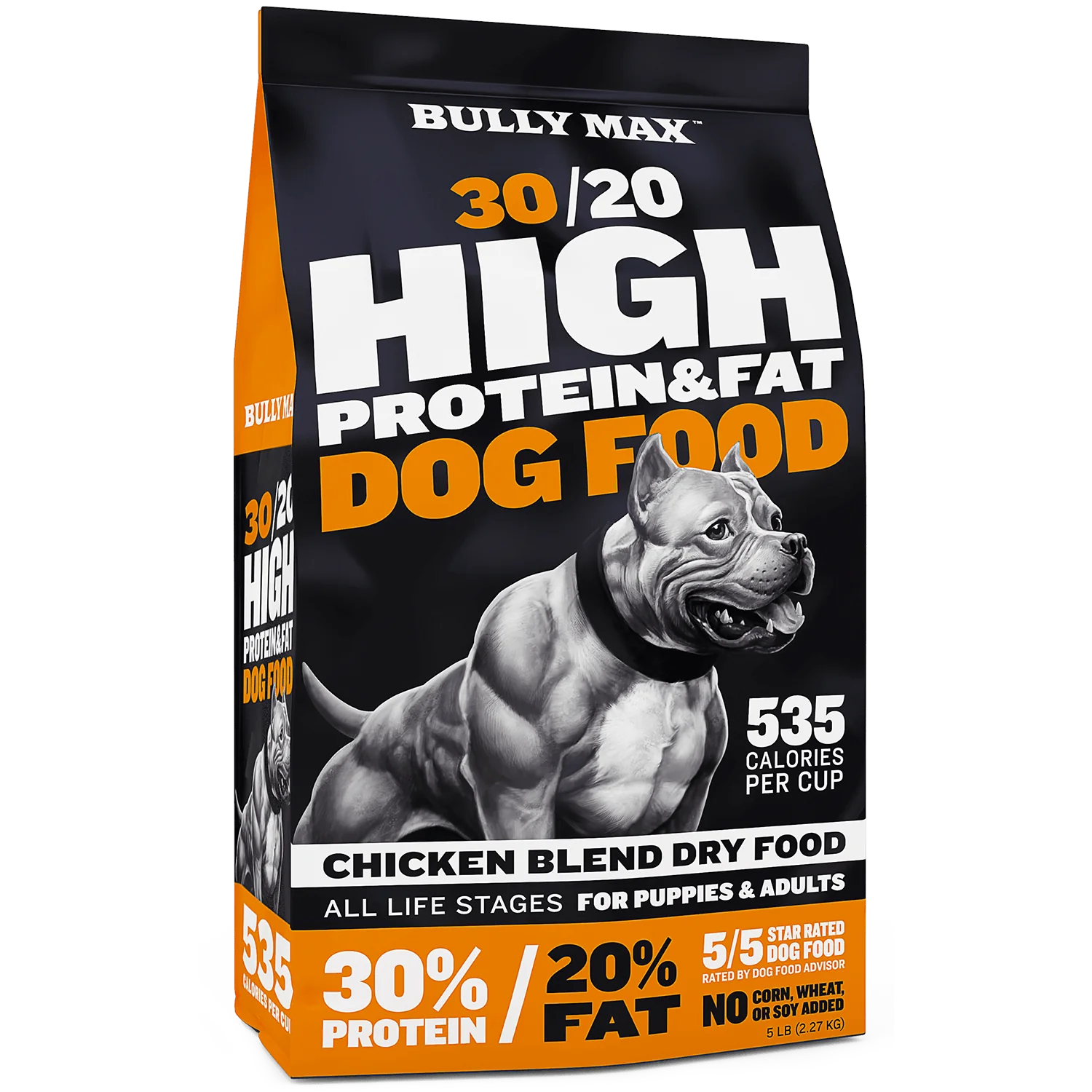
DogFoodAdvisor is reader supported See how
All reviews are 100% impartial but if you buy using links on this page, we may earn a referral fee.
Our Verdict
Bully Max High Performance product range is made up of five recipes with ratings varying from 4 to 5 stars. The average rating of the whole range is 4.5 stars.
The table below shows each recipe in this range including our rating and the AAFCO nutrient profile: Growth (puppy), Maintenance (adult), All Life Stages, Supplemental or Unspecified.
| Product line | Rating | AAFCO |
|---|---|---|
| Bully Max 30/20 High Performance | 5 | U |
| Bully Max 25/11 High Protein 45% Less Fat | 4 | A |
| Bully Max Pro Series 31/25 High Calorie | 4.5 | A |
| Bully Max 24/14 High Protein and Growth | 4 | A |
| Bully Max 26/14 Small Breed | 4.5 | A |
Recipe and Label Analysis
Bully Max 30/20 High Performance was selected to represent both products in the line for detailed recipe and nutrient analysis.
Bully Max 30/20 High Performance
Estimated Dry Matter Nutrient Content
Protein
Fat
CarbsCarbohydrates
Chicken meal, brown rice, chicken fat (preserved with mixed tocopherols), dried plain beet pulp, ground grain sorghum, whitefish meal, pearled barley, brewers dried yeast, ground flaxseed, egg product, natural flavor, yeast culture, menhaden fish oil, potassium chloride, monosodium phosphate, dl-methionine, l-lysine, propionic acid (a preservative), vitamin E supplement, ascorbic acid, niacin supplement, organic dried kelp, d-calcium pantothenate, riboflavin supplement, biotin, vitamin B12 supplement, thiamine mononitrate, vitamin A acetate, pyridoxine hydrochloride, citric acid, vitamin D3 supplement, folic acid, iron sulfate, zinc sulfate, zinc proteinate, iron proteinate, copper sulfate, zinc oxide, manganese sulfate, manganese proteinate, copper proteinate, manganous oxide, sodium selenite, calcium iodate, lactobacillus acidophilus fermentation product dehydrated, dried lactobacillus casei fermentation product, dried bifidobacterium animalis fermentation product, dried lactobacillus reuteri fermentation product
Fiber (estimated dry matter content) = 3.8%
Red denotes any controversial items
| Estimated Nutrient Content | |||
|---|---|---|---|
| Method | Protein | Fat | Carbs |
| Guaranteed Analysis | 30% | 20% | NA |
| Dry Matter Basis | 33% | 22% | 37% |
| Calorie Weighted Basis | 27% | 44% | 30% |
Ingredients Analysis
The first ingredient in this dog food is chicken meal. Chicken meal is considered a meat concentrate and contains nearly 300% more protein than fresh chicken.
The second ingredient is brown rice, a complex carbohydrate that (once cooked) can be fairly easy to digest. However, aside from its natural energy content, rice is of only modest nutritional value to a dog.
The third ingredient is chicken fat. This item is obtained from rendering chicken, a process similar to making soup in which the fat itself is skimmed from the surface of the liquid.
Chicken fat is high in linoleic acid, an omega-6 fatty acid essential for life. Although it doesn’t sound very appetizing, chicken fat is actually a quality ingredient.
The fourth ingredient includes beet pulp. Beet pulp is a controversial ingredient, a high fiber by-product of sugar beet processing.
Some denounce beet pulp as an inexpensive filler while others cite its outstanding intestinal health and blood sugar benefits.
We only call your attention here to the controversy and believe the inclusion of beet pulp in reasonable amounts in most dog foods is entirely acceptable.
The fifth ingredient is sorghum. Sorghum (milo) is a starchy cereal grain with a nutrient profile similar to corn.
Since it is gluten-free and boasts a smoother blood sugar behavior than other grains, sorghum may be considered an acceptable non-meat ingredient.
The sixth ingredient is whitefish meal. Because it is considered a meat concentrate, fish meal contains almost 300% more protein than fresh fish itself.
Fish meal is typically obtained from the “clean, dried, ground tissue of undecomposed whole fish and fish cuttings” of commercial fish operations.[1. Association of American Feed Control Officials.
The seventh ingredient includes brewers yeast, which can be a controversial item. Although it’s a by-product of the beer making process, this ingredient is rich in minerals and other healthy nutrients.
Fans believe yeast repels fleas and supports the immune system.
Critics argue yeast ingredients can be linked to allergies. This may be true, but (like all allergies) only if your particular dog is allergic to the yeast itself.
In addition, a vocal minority insists yeast can increase the risk of developing the life-threatening condition known as bloat. However, this is a claim we’ve not been able to scientifically verify.
In any case, unless your dog is specifically allergic to it, yeast can still be considered a nutritious additive.
What’s more noteworthy here is that brewers yeast contains about 48% protein, a factor that must be considered when judging the actual meat content of this dog food.
The eighth ingredient is flaxseed, one of the best plant sources of healthy omega-3 fatty acids. Provided they’ve first been ground into a meal, flax seeds are also rich in soluble fiber.
However, flaxseed contains about 19% protein, a factor that must be considered when judging the actual meat content of this dog food.
From here, the list goes on to include a number of other items.
But to be realistic, ingredients located this far down the list (other than nutritional supplements) are not likely to affect the overall rating of this Bully Max product.
With 5 notable exceptions…
First, we find egg product, an unspecified (wet or dry?) form of shell-free eggs. Quality can vary significantly. Lower grade egg product can even come from commercial hatcheries — from eggs that have failed to hatch.
In any case, eggs are easy to digest and have an exceptionally high biological value.
Next, this food contains menhaden oil. Menhaden are small ocean fish related to herring. Their oil is naturally rich in the prized EPA and DHA type of omega-3 fatty acids, two high quality fats boasting the highest bio-availability to both dogs and humans.
What’s more, in their mid-depth habitat, menhaden are not as likely to be exposed to mercury contamination as is typical with deep water species.
In addition, we note the inclusion of dried fermentation products in this recipe. Fermentation products are typically added to provide enzymes to aid the animal with digestion.
Next, this recipe contains chelated minerals, minerals that have been chemically attached to protein. This makes them easier to absorb. Chelated minerals are usually found in better dog foods.
And lastly, this recipe includes sodium selenite, a controversial form of the mineral selenium. Sodium selenite appears to be nutritionally inferior to the more natural source of selenium found in selenium yeast.
Nutrient Analysis
Based on its ingredients alone, Bully Max Performance Dog Food looks like an above-average dry product.
The dashboard displays a dry matter protein reading of 33%, a fat level of 22% and estimated carbohydrates of about 36%.
As a group, the brand features an average protein content of 31% and a mean fat level of 19%. Together, these figures suggest a carbohydrate content of 42% for the overall product line.
And a fat-to-protein ratio of about 62%.
Above-average protein. Above-average fat. And below-average carbs when compared to a typical dry dog food.
Even when you consider the protein-boosting effect of the brewers yeast and flaxseed, this looks like the profile of a dry product containing a significant amount of meat.
Bully Max Dog Food Recall History
The following automated list (if present) includes all dog food recalls related to Bully Max through January 2025.
No recalls noted.
You can view a complete list of all dog food recalls since 2009 here.
Our Rating of Bully Max High Performance Dog Food
Bully Max Performance is a grain-inclusive dry dog food using a significant amount of named meat meal as its dominant source of animal protein, thus earning the brand 4.5 stars.
Compare Bully Max High Performance Dog Food
How does Bully Max High Performance compare with The Dog Food Advisor's most recommended brands?
A Final Word
The Dog Food Advisor does not accept money, gifts, samples or other incentives in exchange for special consideration in preparing our reviews.
However, we do receive a referral fee from online retailers (like Chewy or Amazon) and from sellers of perishable pet food when readers click over to their websites from ours. This helps cover the cost of operation of our free blog. Thanks for your support.
For more information, please visit our Disclaimer and Disclosure page.








